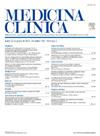肾脏捐献:接受标准及其对捐献后5年和10年的影响
IF 2.1
4区 医学
Q1 MEDICINE, GENERAL & INTERNAL
引用次数: 0
摘要
随着时间的推移,肾供者的接受标准变得更加灵活,这引发了对其长期后果的质疑。本研究的目的是评估接受KDs基线特征的变化,并分析其捐赠后的演变。方法采用队列研究方法,纳入我院2010 - 2017年所有儿科医师。基线特征按时间进行比较,并在捐赠后随访10年。结果共纳入KDs 169例,年龄45.6±12.2岁,以女性居多(63.9%)。他们的主要合并症是肥胖(29.6%)和控制动脉高血压(10.7%)。KDs在肾小球滤过率(eGFR)估计值上有显著差异,在最后一个研究期间数值较低(P = 0.002)。进展为慢性肾脏疾病(CKD) III-a为31% (95% CI: 23.5-39.6), III-b为3.9% (95% CI: 0.5-7.2)。相关危险因素为年龄(HRa = 1.04;95% ci: 1.01-1,07;P = 0.033)和捐献前eGFR (HRa = 0.97;95% ci: 0.95-0,99;p = .028)。随访期间无患者进展为CKD IV、V或死亡。ConclusionThere是细微变化的特点,接受了KR。年龄和基线eGFR CKD三世post-donation是进展的独立预测指标。在捐赠后10年的随访中,晚期CKD的发生率和死亡率为零,因此在我们的环境中,从长远来看,这似乎是一个安全的手术。本文章由计算机程序翻译,如有差异,请以英文原文为准。
Donación renal: criterios de aceptación y su influencia a los 5 y 10 años post donación
Introduction
Acceptance criteria for kidney donors (KDs) have become more flexible over time, raising questions about their long-term consequences. The objective of this study was to evaluate changes in the baseline characteristics of accepted KDs and to analyze their evolution after donation.
Methods
A cohort study was conducted that included all KDs from our institution from 2010 to 2017. Baseline characteristics were compared by period and follow-up was carried out up to 10 years after donation.
Results
169 KDs aged 45.6 ± 12.2 years were included, mostly women (63.9%). The main comorbidity they presented was obesity (29.6%) and controlled arterial hypertension (10.7%). KDs showed significant differences in estimated glomerular filtration rate (eGFR) with lower values in the last study period (P = .002). Progression to chronic kidney disease (CKD) III-a was 31% (95% CI: 23.5-39.6) and III-b 3.9% (95% CI: 0.5-7.2). Related risk factors were age (HRa = 1.04; 95% CI: 1.01-1,07; P = .033) and pre-donation eGFR (HRa = 0,97; 95% CI: 0.95-0,99; P = .028). No patient progressed to CKD IV, V or died during follow-up.
Conclusion
There were subtle changes in the characteristics of the accepted KR. Age and baseline eGFR were independent predictors of progression to CKD III post-donation. The incidence of advanced CKD and mortality were null at 10 years of post-donation follow-up, so it seems to be a safe procedure in our environment in the long term.
求助全文
通过发布文献求助,成功后即可免费获取论文全文。
去求助
来源期刊

Medicina Clinica
医学-医学:内科
CiteScore
3.10
自引率
5.10%
发文量
295
审稿时长
22 days
期刊介绍:
Medicina Clínica, fundada en 1943, es una publicación quincenal dedicada a la promoción de la investigación y de la práctica clínica entre los especialistas de la medicina interna, así como otras especialidades. Son características fundamentales de esta publicación el rigor científico y metodológico de sus artículos, la actualidad de los temas y, sobre todo, su sentido práctico, buscando siempre que la información sea de la mayor utilidad en la práctica clínica.
 求助内容:
求助内容: 应助结果提醒方式:
应助结果提醒方式:


